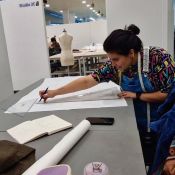
Graphic Design in the UK
Graphic design involves communicating a message by analysing, designing and producing visual expressions for different media, platforms and target groups. Through a focus on idea and concept development, the study combines principles from traditional design and multimedia to create innovative methods for visual communication on both printed and digital media. Increasing focus on social media and digital platforms has made graphic design an essential part of branding across a number of different industries, and has contributed to graphic design becoming an innovative and versatile discipline.
THE GRAPHIC DESIGN DEGREE
The degree in graphic design combines individual creativity with technical skills to create new and effective expressions for visual communication. Great emphasis is placed on innovation and experimentation to develop new ideas and create an individual approach to design and communication. The course is developed in step with the media industry, which means that students often have access to the latest in research and communication theory, as well as equipment and software from several fields in the design industry. The aim is for the students to build up a versatile portfolio to prepare for an industry in constant development.
This course is suitable for you if you are creative and good at communicating your ideas. You must be able to demonstrate skills in visual composition, design, drawing, idea development or other forms of visual communication, as well as an interest in different media. You must be solution-oriented and have an ability to think outside the box. It is a great advantage to have certain technical skills, but it is not always a requirement as you can often learn this during your degree. It is also important that you can work independently, but also as part of a team.
Through the course, you will get a comprehensive introduction to basic design principles, such as form, composition, movement, colour, texture and digital graphics from lecturers and technicians with long experience in the industry. To get an impression of the different directions within the design industry, you will also get an introduction to a number of different media and industries, such as web design, advertising, TV, print, magazines, typography, etc. You will be trained in a variety of different software, such as InDesign and Photoshop, and many universities may also offer training in techniques and software from other fields, such as 3D, interactive design and virtual reality. You will learn basic principles in communication and concept development, and how you can communicate an idea to a specific target group. The teaching is also supported by theoretical teaching in media studies, design strategy and target group analyses.
THE TEACHING
Teaching takes place both in the form of lectures, seminars, workshops and practical studio work. The theoretical teaching is often held for larger groups or entire cohorts, while you will be divided into smaller groups for seminars, workshops and tutorials. In this way, you will be able to get to know the lecturers and be followed up personally throughout the course. An important part of the degree in graphic design is constant feedback, both during the course and on finished work. Great emphasis is placed on 'critiques' - where you present your work to fellow students and academics, as well as large and small exhibitions for the university's students, and finally for the whole city. Most universities have their own third-year exhibition, which is often held in London or other large cities in the UK or Europe, and these are often visited by attractive employers.
Some universities offer specialised combination studies in graphic design with photography, multimedia or illustration, but since graphic design is such a versatile discipline, most universities will offer graphic design as a separate degree, so that you can choose different modules within your degree. In this way, you will first learn the most important principles within graphic design, before you can eventually choose one or more specialties or combinations to develop your works. Since graphic design has become an important part of most industries in the world, there are often endless combinations and directions to choose from. Some examples can be: multimedia, interactive media, 3D, animation, photography, printed matter, advertising, communication, journalism and more. The course places great emphasis on exploring new expressions and media, so many universities also encourage collaboration between different lines and disciplines to create something unique.
ENTRY REQUIREMENTS
Portfolio will be a large part of admission to Graphic Design degrees, and the universities attach great importance to this. In addition to the portfolio, the Personal Statement will be an important part of the application. We will be working together with you to make your application the best it can possibly be!
WORK PLACEMENTS
Our universities give you the opportunity to do a placement, either as part of a semester or as a whole year. Some universities also have their own mentoring programmes where you can be connected to a company or graphic designer who can give you advice during your studies, and perhaps offer you a placement - and sometimes a job - after completing your studies! If you want to take part of the education in another country, that is also possible! Many of our universities offer placements all over the world, ranging from a few weeks to a whole semester or year. These opportunities will vary from university to university, so get in touch with us at Across the Pond and we can help you find what suits you best!
MASTER'S DEGREE IN ONE YEAR
After completing an undergraduate degree, you have a broad background and you qualify for a number of master's degrees. In the UK you can apply for almost any master's degree without necessarily having an undergraduate in the same field of study. Of course, a relevant bachelor's degree would be advantageous, but it is not always a requirement. After completing an undergraduate degree, you will also be able to go on to a master's degrees in for instance Business, Management, Marketing etc. Across the Pond advisors are happy to send you suggestions for courses that will suit you. In the UK, a master's degrees usually takes one year.
JOB OPPORTUNITIES
Graphic design has become an increasingly important part of branding and communication in today's market, and with a degree in graphic design you will have the opportunity to work in a number of different industries, such as design, advertising, publishing, marketing, PR, web, media production and many more. You can choose to work in your own design companies, or you can also choose to work permanently in companies that have their own media/design houses. Many of those who study graphic design also choose to work as a freelancer or start their own businesses, there are many opportunities for those who want to study graphic design.
We also recommend working in your home country during the holidays while you are a student in the UK. When you are looking for a job after graduation, it will be a huge advantage to be able to have work experience on your CV, but it will also be very useful to start as early as possible to make contacts in working life. You often have long holidays as a student in the UK, so there are good opportunities to be able to go home and work during these periods.

















